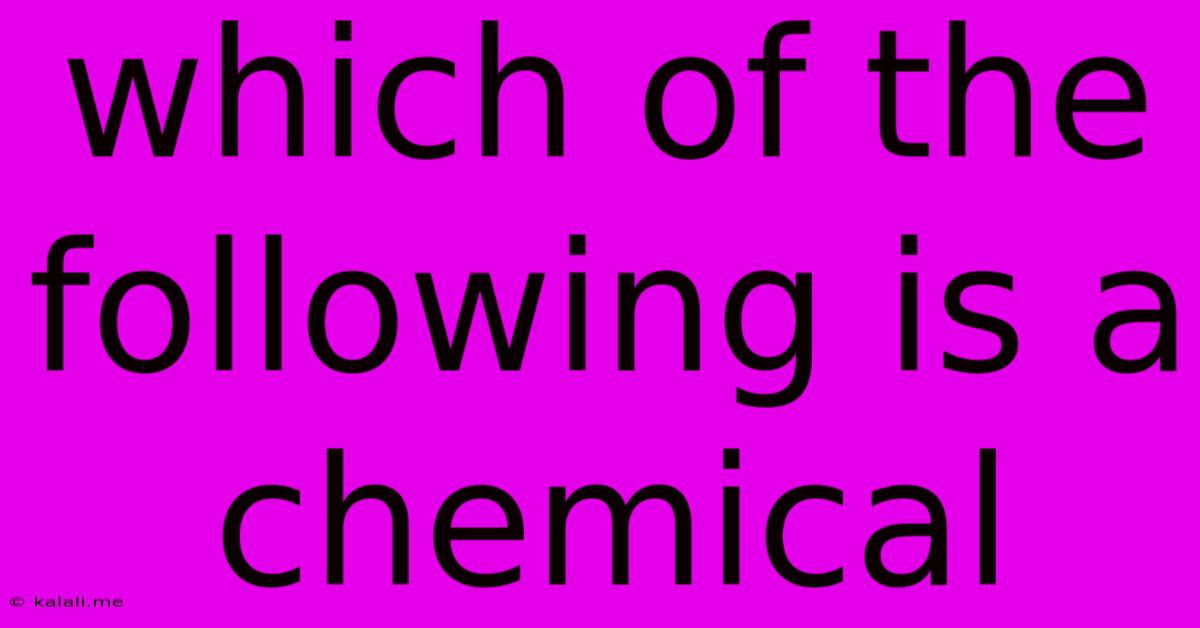Which Of The Following Is A Chemical
Kalali
Jun 15, 2025 · 3 min read

Table of Contents
Which of the Following is a Chemical? Understanding the Nature of Matter
This article explores the fundamental concept of what constitutes a chemical, clarifying the often-misunderstood distinction between chemicals and other substances. We'll examine several examples and explain why certain items are, undeniably, chemicals, while others might be considered mixtures or other forms of matter. Understanding this distinction is crucial for anyone studying chemistry, materials science, or even everyday life, as everything is essentially made of chemicals.
What is a Chemical?
Before we delve into specific examples, let's define our terms. A chemical is any substance composed of matter. More specifically, a chemical is a substance with a defined chemical composition and consistent properties. This includes elements, compounds, and even mixtures with a specific ratio of components. Essentially, anything that has a chemical formula (even if it's a complex one) is a chemical.
This definition broadens our understanding beyond the typical connotations associated with the word "chemical." Often, the word conjures images of artificial or potentially harmful substances. However, this is a misconception. Water (H₂O), for example, is a chemical. So is table salt (NaCl), sugar (C₁₂H₂₂O₁₁), and the air we breathe (a mixture of various chemical compounds like nitrogen, oxygen, and carbon dioxide).
Examples: Identifying Chemicals in Everyday Life
Let's consider some examples to illustrate the point:
-
Option A: A wooden table: Wood is a natural material composed of cellulose, lignin, and other organic compounds. Therefore, a wooden table is certainly made of various chemicals.
-
Option B: Pure gold: Gold (Au) is a chemical element. It's a fundamental building block of matter and therefore a chemical in its purest form.
-
Option C: A glass of tap water: As mentioned previously, water (H₂O) is a chemical compound. However, tap water is a mixture containing water plus dissolved minerals and other impurities. While predominantly water, it's not a pure chemical substance.
-
Option D: A mixture of sand and sugar: This is a mixture of two distinct chemical compounds – silicon dioxide (sand) and sucrose (sugar). While each component is a chemical, the mixture itself isn't considered a single pure chemical.
Key Considerations for Identifying Chemicals:
-
Pure Substances vs. Mixtures: Pure substances, such as elements and compounds, are considered single chemicals. Mixtures, like tap water or the sand-sugar combination, are composed of multiple chemicals but aren't considered single chemicals in themselves.
-
Natural vs. Synthetic: The origin of a substance (natural or synthetic) doesn't determine if it is a chemical. Both natural and synthetic materials are composed of chemicals.
Conclusion:
The vast majority of materials we encounter daily are either pure chemicals or mixtures of chemicals. The word "chemical" shouldn't be perceived negatively; it simply denotes a substance with a defined composition and properties. By understanding the basic definition of a chemical and the distinctions between pure substances and mixtures, we gain a more nuanced appreciation of the material world around us. Ultimately, everything is made of chemicals; it's simply a matter of understanding the specific components and their interactions.
Latest Posts
Latest Posts
-
What Is The Least Common Multiple Of 12 And 40
Jun 15, 2025
-
What Is The Prime Factorization Of 160
Jun 15, 2025
-
Which Reinforcement Schedule Is Most Effective
Jun 15, 2025
-
Which Word Is An Antonym Of Lament
Jun 15, 2025
-
How Are Observations And Inferences Different
Jun 15, 2025
Related Post
Thank you for visiting our website which covers about Which Of The Following Is A Chemical . We hope the information provided has been useful to you. Feel free to contact us if you have any questions or need further assistance. See you next time and don't miss to bookmark.